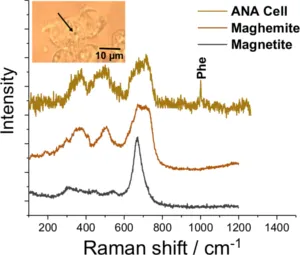Engineered Biomagnetic Interfaces for Non-invasive Molecular Control / BIOMAG
Objectives
- Development of nondestructive technology for molecular control
- Analysis of magnetic properties for different proteins
Method of Approach
- Raman microspectroscopy
- Equipment for cellular treatment
Description
Among various iron oxides, Magnetite (Fe3O4) and Maghemite (gamma-Fe2O3) are the only ones with the greatest interest in many biological and medical applications such as cell tracking and medical imaging due to their superparamagnetic properties. However, most of the current methods rely on cells with chemically synthesized magnetic nanoparticles, which could be a negative effect to their e.g. biocompatibility. To obviate this problem, natural iron containing substances in cells or proteins are of great interest. Some bacteria such as magnetotactic bacteria are able to assemble chains of magnetic crystals, so-calles magnetosomes that simplify navigation similar to a compass needle. These magnetosomes are about 30 - 100 nm size and are filled with magnetite, a specific crystal of iron-oxide with superparamagnetic properties. The natural ability of these biological organisms to generate paramagnetic material is an inspiring prospect for biomimetic innovation, since the crucial advantage of magnetic fields is that they penetrate much deeper through biological tissue than photons and can actuate cellular biomagnetic interfaces in entire organisms non-invasively. In this work we combine bioengineering and physicochemical analyses of genetically induces magnetic biomineralization in mammalian cell to enable non-invasive control of molecular processes via magnetic fields.
The need for photon-independent such as optoacoustic control of cellular processes has already been spurred a number of approaches focused for instance on magnetic control of cellular growth and differentiation. However, the central weakness of current approaches is the need to use synthetic nanoparticles. Overall objective of our project is to genetically reprogram cells to obtain magnetic properties such that they can (A) be selectively visualized in MRI and/or (B) be manipulated via magnetic field gradients. This will be achieved via expression or suppression of sets of genes controlling magnetic biomineralization.
For detailed characterization of the exact species of iron metal deposits with subcellular resolution, Raman microspectroscopy can be applied which is a powerful tool for the analysis of different minerals and require no or minimal sample preparation. The non-destructive analytical method is based on the effect of inelastic light scattering and provides spectra with the spatial resolution of an optical microscope for the identification and structural analyses of various iron oxides and oxyhydroxides (see Figure). Since water is a weak Raman scatter, the measurements of biological samples can be carried out in a physiologically buffered environment.
Special attention will be paid to the optimization of measurement conditions for single spectra and Raman maps (spectral imaging) without compromising cell viability. Furthermore, applying RM in combination with the DuoScan-technique allows us to achieve chemical imaging of iron species with a spatial resolution below the diffraction limit.

Pubilcations
C. Hartmann, M. Elsner, R. Niessner & N. P. Ivleva, Nondestructive Chemical Analysis of the Iron-Containing Protein Ferritin Using Raman Microspectroscopy. Applied Spectroscopy 2020, 74(2),193-203, doi.org/10.1177/0003702818823203
C. Massner, F. Sigmund, S. Pettinger, M. Seeger, C. Hartmann, N. P. Ivleva, R. Niessner, H. Fuchs, M. H. de Angelis, A. Stelzl, N. L. Koonakampully, H. Rolbieski, U. Wiedwald, M. Spasova, W. Wurst, V. Ntziachristos, M. Winklhofer & G. G. Westmeyer, Genetically Controlled Lysosomal Entrapment of Superparamagnetic Ferritin for Multimodal and Multiscale Imaging and Actuation with Low Tissue Attenuation. Advanced Functional Materials 2018, 28, doi.org/10.1002/adfm.201706793
A. Nistler, C. Hartmann, C. Rümenapp, M. Opel, B. Gleich, N. P. Ivleva, R. Niessner & M. Seidel, Production and Characterization of Long-Term Stable Superparamagnetic Iron Oxide-Shell Silica-Core Nanocomposites, Journal of Magnetism and Magnetic Materials 2017, 497-503, doi.org/10.1016/j.jmmm.2017.07.005